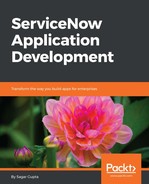The columns of a table, also referred to as fields, are stored as Dictionary Entries, and are unique to each table. The sys_id column is the 32-character unique identifier field available in all ServiceNow tables. A parent class may have a set of columns; however, a child class can have its own set of columns, along with the columns it has inherited, by extending the parent class. Thus, the dictionary entry for a child class only contains the columns unique to the child class. We will cover creating columns in Chapter 5, Modules, Forms, and Views.
The dictionary entry of a child class contains the fields created explicitly in that child class and not the ones inherited from the parent class. So a record in the child class will have values in both the child class and all of its parent classes, which means that a record in the child class consists of a set of values spanning columns in all parent tables and that share the same sys_id value in the unique identifier field.
The system tracks record changes by the sys_id value and applies any change to all classes that have a record with the matching sys_id value. For example, if we insert a new record in the child incident table, a new corresponding record will also be inserted in the parent Task table, and both rows will share the same sys_id.
